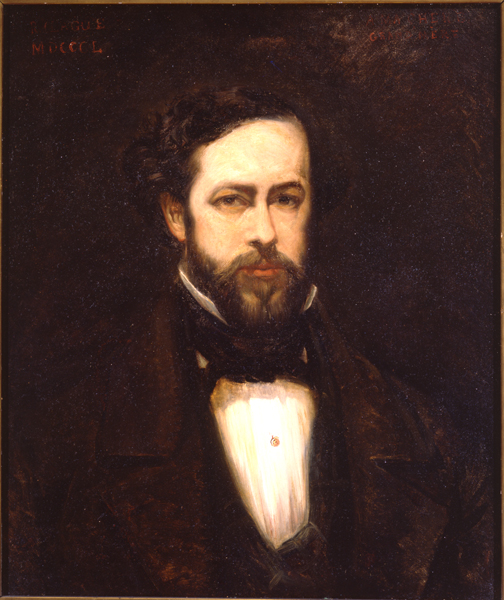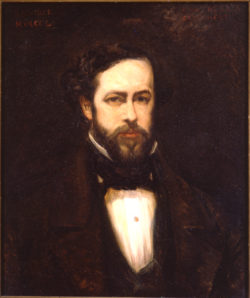Richard Clague Jr.
Widely credited as the founder of the landscape painting tradition in Louisiana, French-born painter Richard Clague received most of his formal artistic training in Europe.

Courtesy of Louisiana State Museum.
Richard Clague Jr. dedicated this self-portrait to his grandmother, Madame Pierre de la Roche of New Orleans, with an inscription which reads, “A ma chère Grand-Mère” (“To My Dear Grandmother”).
Gidely credited as the founder of the landscape painting tradition in Louisiana, French-born painter Richard Clague received most of his formal artistic training in Europe. While landscape painting had gained some popularity in the northern states by the early nineteenth century and there was a strong tradition of decorative and scenic painting, portraiture remained the primary focus of antebellum southern artists. Clague helped define a market for easel-size landscapes following the Civil War. Influenced by realism and the Barbizon School in France, Clague’s naturalistic approach to landscape painting appealed to middle-class patrons. He was also among the most successful teachers in Louisiana, inspiring a generation of landscape painters known as the “Bayou School.”
Early Life and Education
Richard Clague was born in Paris, France, on May 11, 1821. His father, whose name he shared, was born on the Isle of Man, and his mother, Marie-Delphine-Justine de la Roche, was a French Creole born in New Orleans. The Clague’s shipping interests, investments in bonds and insurance, and involvement in the slave trade had made them quite prosperous. Though the family divided time between Paris and New Orleans after 1824, records indicate that Richard Clague was baptized at St. Louis Cathedral in the French Quarter on February 17, 1827. The couple had two other sons, Edouard and Charles Frederick. Richard, Sr., also had a son with Adele Wiltz, a free woman of color. Many have speculated that the affair precipitated the rare legal separation of Clague and his wife in 1832.
After the separation, Richard Clague, Jr., moved to Paris with his mother and younger brothers. With his father’s support, he began studying painting with his brother Edouard in Geneva, Switzerland. In 1836 and 1837, he studied with animalier and landscape painter Jean Ferdinand Humbert in Switzerland. Clague’s earliest extant works reflect the pastoral traditions advocated at the École des Beaux Arts, an influential French art school, where Humbert had studied. After his father’s death in December 1836, Clague received a large inheritance, allowing him the luxury of prolonged study and independence. Back in New Orleans with Edouard, he studied with Léon Pomerade, a French émigré artist, from 1842 to 1843.
In 1844, Clague returned to Paris, presumably to collect the proceeds of his father’s government bonds. Little is known of his activities between this period and 1849, when he enrolled in the École des Beaux Arts under the sponsorship of French painter François Edouard Picot. It is likely that he studied privately with Picot during the intervening years. Clague also claimed to have studied with Antoine Auguste Ernest Hébert and Horace Vernet, both conservative, highly successful Academic painters in France.
Career Development
Clague exhibited at the first non-juried Salon, an official art exhibition sponsored by the Académie des Beaux-Arts in Paris, during the turbulent years of 1848 and 1849. He was also listed as a student at the École in 1849. The landscapes of Camille Corot and especially Theodore Rousseau, both associated with the French Barbizon style, apparently had a more profound and enduring impact on the development of his style than his instructors at the École. Painting outdoors or en plein aire, the Barbizon School advocated naturalistic landscape for its own sake, divested of historical, poetic, mythological, or other associations. Clague’s embraced a similar philosophy in much of his own work.
By 1850, Claque was back in New Orleans with a studio at 40 Camp Street, listed in the city directory as a painter and teacher. The following year, he moved to 102 Royal Street. However, he seems to have lived primarily in France, opening a photography studio in Paris about 1853. The same year, he exhibited a portrait of Pauline Touzé, his mistress and mother of two daughters, at the Salon. It is unclear whether the couple ever married, but Clague described himself as single in 1861.
From November 1856 to March 1857, Clague traveled to Egypt with the French Army. According to New Orleans papers, he worked as a “special artist” on an expedition to find the source of the Nile River. Given the École’s curricular emphasis on drawing, it is not surprising that landscape sketches Clague produced on this trip demonstrated a mastery of French academic practices and conventions.
Life in Louisiana
In 1857, Clague returned to Louisiana to establish an essentially permanent residence. With younger French émigré artist Paul E. Poincy, he rented a studio on Camp Street. Both Clague and Poincy concentrated on portraits and their work strongly suggest the influence of Ingres. Both briefly enlisted as officers in the Confederate 10th Louisiana Infantry during the Civil War. Like many Louisianans, Clague was financially devastated by the upheaval following the war. He spent his remaining years living modestly in Louisiana, often staying with the de Breuys family, to whom he was related.
When Clague began to concentrate on landscape painting in the early 1860s, few American artists—and even fewer Southern ones—had focused on the subject. In 1853, writer T. Addison Richardson noted this lack of appreciation in Harper’s Weekly, concluding that while “pleasing to the eye,” “little has yet been said, either in picture or story of the natural scenery of the southern states.” To be fair, military officers with a topographical interest had frequently sketched Southern scenes. Visiting or semi-resident artists such as Leon Pomerade, whose work influenced Clague’s, had also some success painting landscapes. However, Clague was the first Louisiana artist to build a reputation on the strength of his landscape painting.
Clague’s approach to landscape painting was shaped by his academic training and suggested the influence of Claude Lorrain, the pastoral tradition, and the Barbizon interest in working directly from nature. Generally, he preferred rustic scenes—albeit controlled and domesticated. His landscapes depict recognizable sites, yet they are mediated by idealized compositional schema. In his work, the seemingly wild and obscure becomes familiar and accessible.
Clague depended in large measure on teaching for income. Notabl students included William Henry Buck and Marshall J. Smith, Jr., as well as George David Coulon, Charles Giroux, William Aiken Walker, and Joseph R. Meeker. Clague and his students often worked in New Orleans’s City Park or at his studio. He also spent many summers during the 1860s working in the wetlands along the southern coast of Louisiana near the resort towns of Mandeville and Abita Springs. He exhibited frequently during these years at the studio of photographer and artist Theodore Lilienthal, as well as those of W. E. Seebold and Frank Waegener.
Clague died in Algiers, across the Mississippi River from New Orleans, on November 29, 1873, at the age of 52. His tomb is located in St. Louis Cemetery No. 2. His obituary in the New Orleans Bee was unequivocal: “Mr. Clague has stood at the head of his profession in this state and his works have always been highly regarded by connoisseurs in New York as well as here.” Clague’s paintings are avidly collected by private individuals and museums. The New Orleans Museum of Art, the Historic New Orleans Collection, Louisiana State Museum, Ogden Museum of Art, and several other institutions maintain important collections of his portraits and landscapes.
